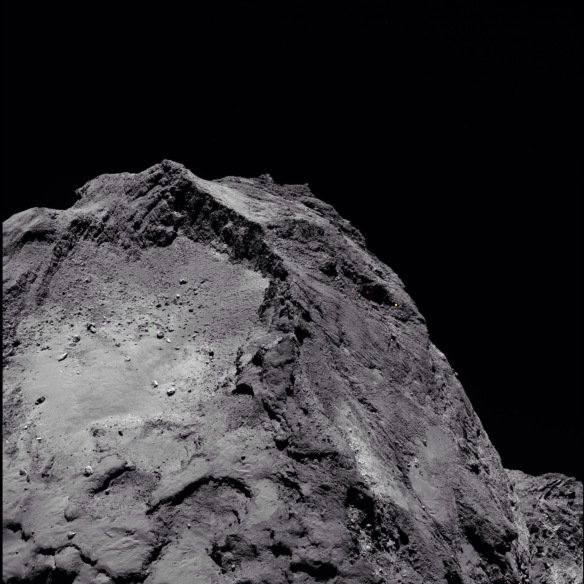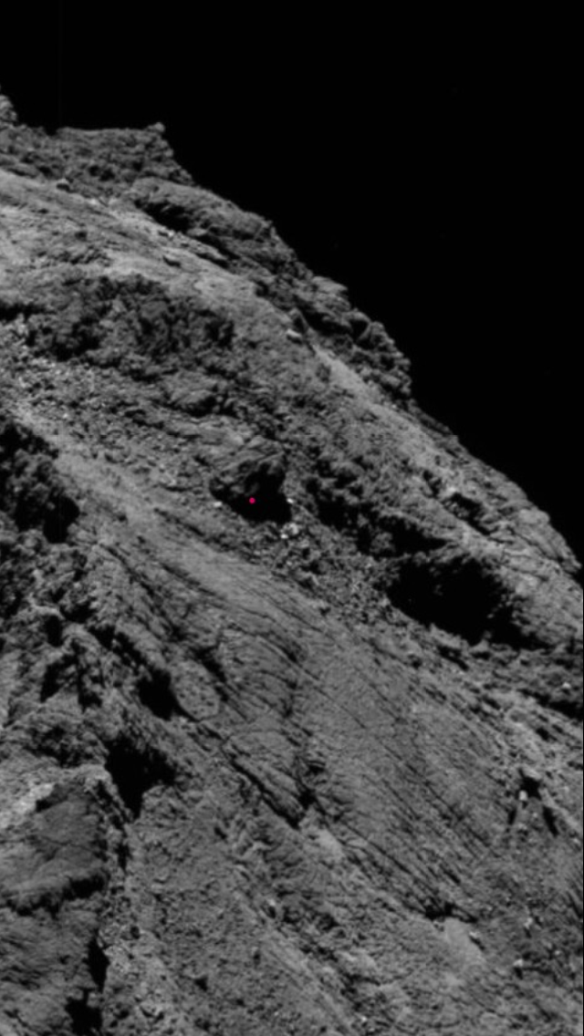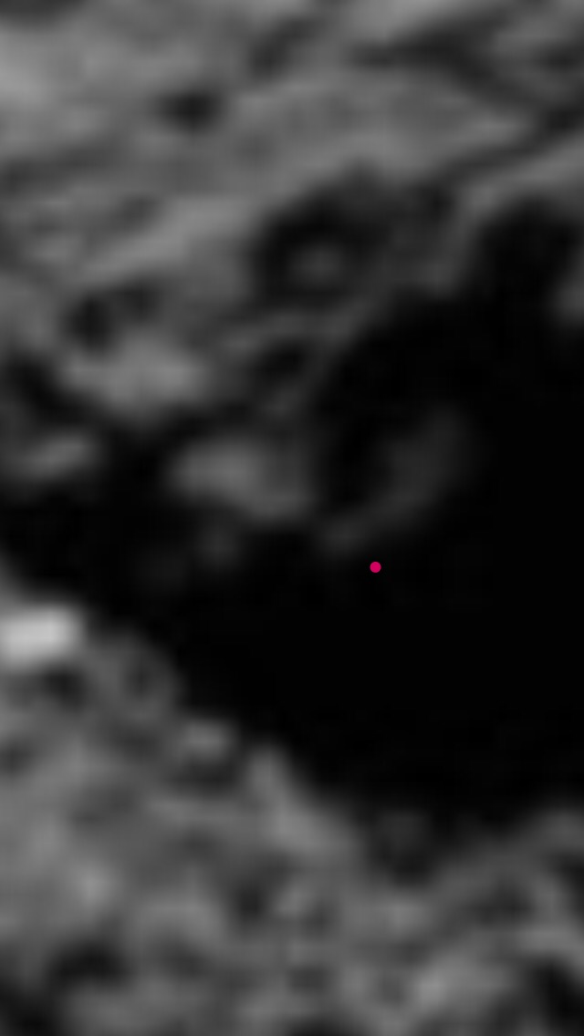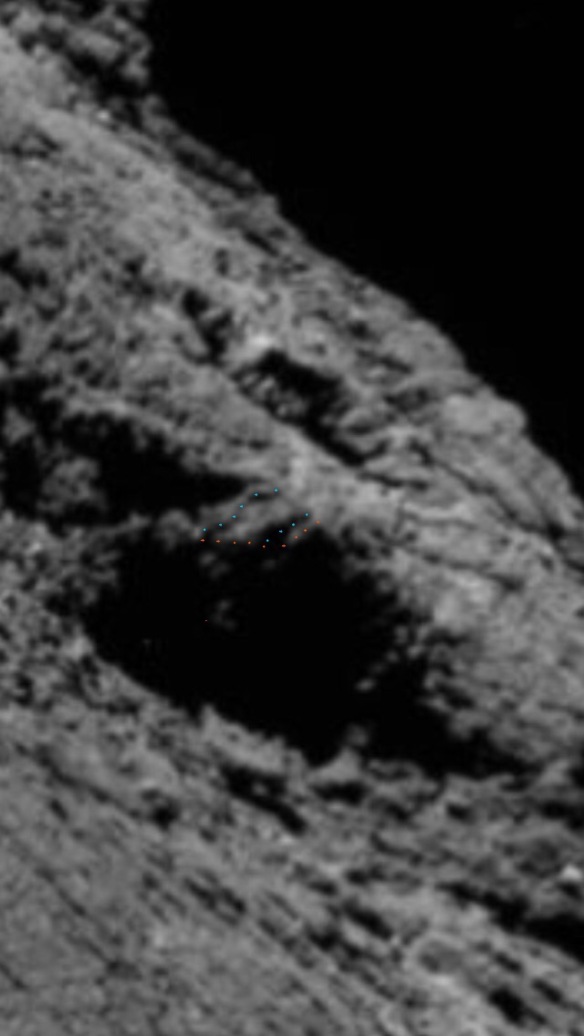Apologies. No it isn’t. See update below header photos. 
 Credit: ESA/Rosetta/MPS for OSIRIS Team MPS/UPD/LAM/IAA/SSO/INTA/UPM/DASP/IDA
Credit: ESA/Rosetta/MPS for OSIRIS Team MPS/UPD/LAM/IAA/SSO/INTA/UPM/DASP/IDA
UPDATE 20th February 2016
It says below re anomalous shadows and highlights, “something this blog is very aware of and careful about”. Obviously not aware and careful enough in this case. After tracing fracture lines across Wosret on the south pole it’s clear that the correct triangular recess is the one to the left of the one cited below so the header image is irrelevant.
The correct recess has a shadow that skirts just above OSIRIS’s suggested Philae position. So Philae isn’t visible in that recess either.
The correct triangular recess and OSIRIS position is shown below (fuchsia dot). There is something to the left of the fuchsia dot that looks a bit like Philae but it would be about 20 metres across.

 This post may get deleted in the future because it serves no purpose. However, it will remain here for a few weeks or months for the sake of transparency.
This post may get deleted in the future because it serves no purpose. However, it will remain here for a few weeks or months for the sake of transparency.
(End of update)
ORIGINAL POST
Key [to original header photos at the top]:
Fuchsia- the suggested location of Philae via the close up in the header. The dot is just to the left of the suggested Philae shape. This is also very close to the ‘OSIRIS location’ put forward by OSIRIS after making a comparison of photos from before and after the Philae landing (see explanation below).
Yellow- the refined ‘CONSERT location’ for Philae is just below and behind (circa 50 metres down) this rim and out of sight. The refined CONSERT location is a circa 20 x 30 metre area at one end of the former ‘CONSERT ellipse’. The ellipse was the rougher version of the location. The CONSERT location was established via radio communication with the orbiter along with permittivity models.
Photo 3- a mid-distance view.
INTRODUCTION
The top header photo is a close up from the second header. The headers are an OSIRIS photo taken on 13th February 2016 and the pixel size at the comet is 0.82 metres. The close-up is the stretch blog’s unofficial suggestion for Philae. However it’s very close to the official OSIRIS suggested location and may shed light on whether their location is indeed correct. It was never stated as being definitive.
THE LOCATION
In December 2014, the OSIRIS team detected a possible location for the lander in a position that was some 50 metres displaced up the head lobe from the CONSERT location. This was done by comparing OSIRIS photos of Abydos, the landing area, from before and after the time of Philae’s landing. It landed on November 12th 2014. The photos were taken under almost the same lighting conditions so as to reduce the possibility of being fooled by anomalous shadows and highlights (something this blog is very aware of and careful about).
The Rosetta blog post showing the so-called OSIRIS location is here with the before/after OSIRIS photos and a very useful 20-second video that zooms right in to the proposed location:
I’m not sure of the copyright status of the November/December 2014 photos and video so I can’t reproduce and annotate them here for the moment. The recent photo is from the OSIRIS archive and can be reproduced.
Although the jury appeared to be out on whether this OSIRIS location really was the true location, it does look very much like Philae. The doubt was due to the CONSERT- derived location being considered as quite robust. The final CONSERT location was narrowed to a circa 20 x30 metre area towards the left hand end of the red ellipse depicted in the video. That puts the purported OSIRIS image of Philae some 50-60 metres distant from this very precise position and even outside the much rougher original ellipse.
The viewing angle in the November 2014, December 2014 photos and video is from the south pole side rather than from across Hatmehit in this photo from February 2016. If you pause the video at the end when the Philae location is ringed, you can see the characteristic triangular dip that it’s sitting in. In the recent photo we’re looking across the ‘horizontal’, triangular top of the dip to the far side which would be the right hand slope in the south pole view.
In both cases, the suggested Philae location is on the same side of the dip. That would be on the right hand slope for the classic OSIRIS location photo and on the far side for this post’s unofficial suggestion.
On the classic OSIRIS location (the video) you can see a little bump in the illuminated, triangular perimeter to the dip. It’s 45° up and to the right of the circled Philae. There are two horizontal, dark lines leading to the right, away across the illuminated rim from the bump.
This same bump and the two dark lines are annotated below in a close up of the February 16th photo:
Photo 4 – the February 2016 version annotated to show the bump and lines.
Orange dots show the bump and light blue lines show the lines which are probably small fissures. The suggested Philae position is dotted with a very small fuchsia dot in the shadow to its left.
As you can see, the bump and blue lines are behind and above the Philae position as you’d expect if they were to the right and above its position in the video.
Furthermore, if you have taken a still of the video when Philae is circled or perhaps just before it’s circled (if confident of its location), you can then toggle it with the relevant close up of the same size from the recent photo (I’d suggest using photo 4 from this post). You can then see that the suggested Philae image in both cases appears to be about the same size in relation to the triangular dip.
Finally, in the recent image, the two visible legs of the supposed Philae are orientated in the same way as the orientation of the nearest two legs in the video.
It might seem a coincidence that just Philae is illuminated in the shadows in the February 2016 photo. However, it’s presumably a lot more reflective than the darker (0.04 albedo) comet. So if there was only a smidgen of reflected light going into the dip, perhaps only the ‘Philae’ pixels would register over an above the detection threshold for the CCD. However, that’s pure speculation. I’m not a CCD expert. Perhaps an expert could weigh in on that.
ALL PHOTO CREDITS:
ESA/Rosetta/MPS for OSIRIS Team MPS/UPD/LAM/IAA/SSO/INTA/UPM/DASP/IDA


